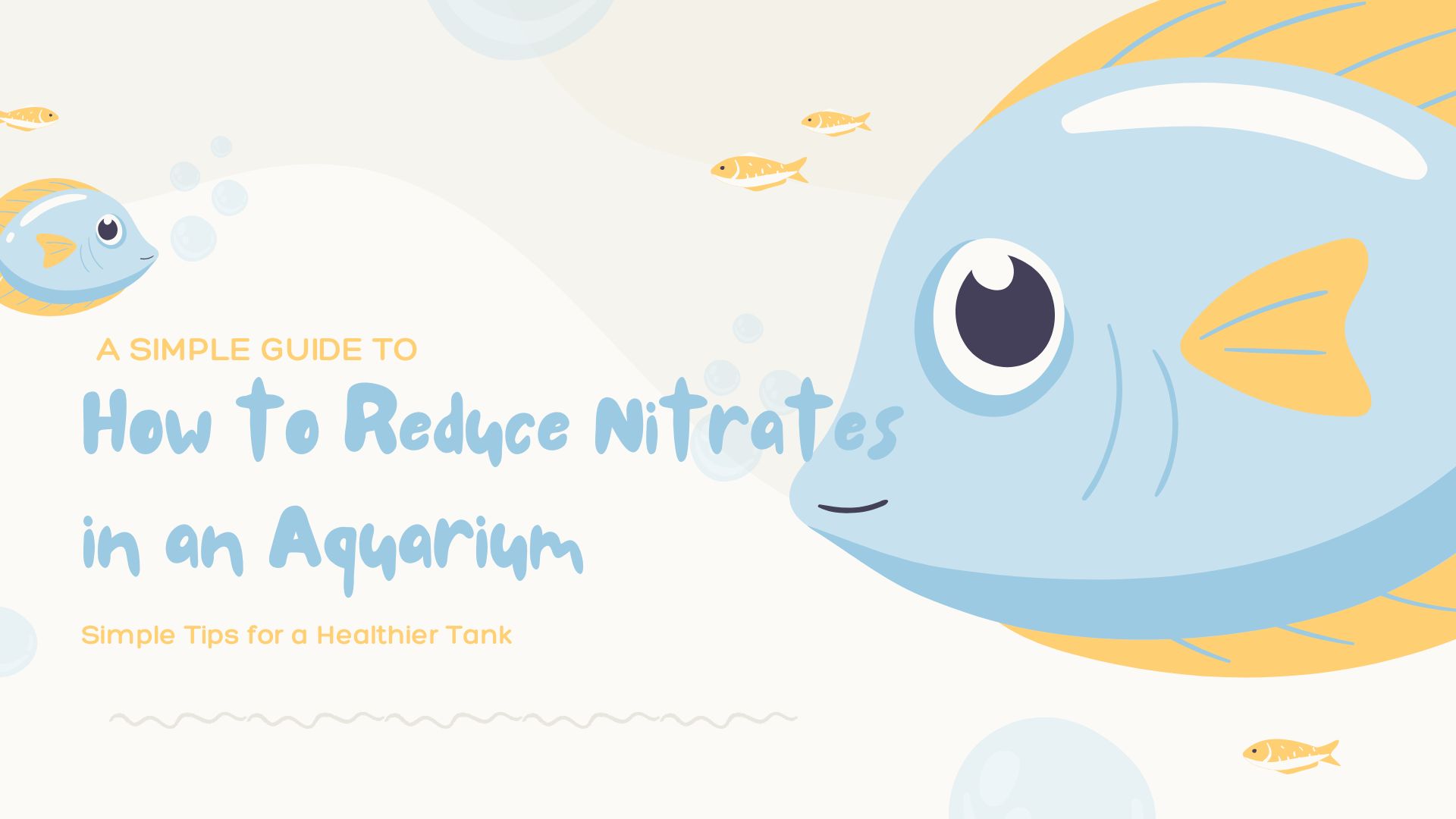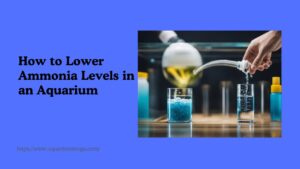Nitrates can be a tricky problem in any aquarium, but I’ve found some effective ways to keep them under control.
The quickest way to reduce nitrates is by performing regular water changes. This simple action can make a big difference in keeping your aquatic environment healthy and thriving.

I like to stay ahead of nitrate buildup by changing out a portion of the water regularly. It not only helps to remove excess nitrates but also keeps my fish happy and vibrant.
Adding live plants or improving filtration also plays a significant role in managing nitrate levels.
Arming yourself with knowledge on this topic can lead to a more successful aquarium.
With just a few changes, you can create a stable and healthy habitat for your fish.
Let’s dive deeper into the best methods for reducing nitrates in your tank.
Contents
- 1 Table of Contents
- 2 Understanding Nitrates in Aquariums
- 3 Regular Water Changes
- 4 Aquarium Maintenance
- 5 Balancing Aquarium Bioload
- 6 Natural Nitrate Reduction Methods
- 7 Chemical Filtration and Nitrate Absorbers
- 8 Upgrading Equipment
- 9 Monitoring Nitrate Levels
- 10 FAQs:
- 10.1 What causes high nitrates in an aquarium?
- 10.2 How to reduce nitrates in an aquarium quickly?
- 10.3 Can live plants help reduce nitrates in an aquarium?
- 10.4 Is it safe to use chemical nitrate removers in an aquarium?
- 10.5 How often should I perform water changes to reduce nitrates in an aquarium?
- 10.6 Can overfeeding increase nitrates in an aquarium?
Table of Contents
Understanding Nitrates in Aquariums
Nitrates are a natural part of the nitrogen cycle in aquariums.
They form when bacteria break down fish waste and uneaten food. While they are necessary, high levels can be harmful to my fish.
In a healthy aquarium, nitrates should stay at safe levels, usually below 20 mg/L. When they rise too high, it can lead to problems like stress and even illness for my fish.
I can introduce nitrates into my tank through various sources, including:
- Fish waste
- Decomposing plant matter
- Uneaten food
To keep nitrates low, I find it helpful to do regular water changes. Replacing about 20% of the water weekly can make a big difference in nitrate levels.
Another effective method is adding live plants. They help absorb nitrates and create a more balanced environment. Some plants to consider are:
- Java Fern
- Anubias
- Water Sprite
Maintaining good filtration also plays a key role. Proper filters can remove waste before it breaks down into nitrates.
In my experience, keeping an eye on water parameters with testing kits can help me manage nitrates. When I monitor regularly, I can create a healthier habitat for my fish and avoid long-term issues.
Regular Water Changes
Keeping nitrate levels low in my aquarium relies heavily on regular water changes. This simple practice can greatly benefit the health of my fish and plants. It’s important to know how often to change the water and how to do it correctly.
Determining Water Change Frequency
I usually aim to change about 10-20% of my aquarium water each week. This helps to keep nitrate levels manageable.
The frequency can depend on several factors:
- Tank Size: Smaller tanks might need more frequent changes.
- Fish Load: More fish produce more waste, needing more water changes.
- Live Plants: A tank with lots of plants may require fewer changes since they absorb nitrates.
Adjusting my schedule based on these factors keeps my environment healthy for my aquatic friends.
Proper Water Change Techniques
When I do water changes, I follow specific steps to make it effective. Here’s what I do:
- Gather Supplies: I need a siphon, bucket, and dechlorinator.
- Siphon Debris: I start by using the siphon to remove debris and waste from the gravel. This helps reduce nitrate buildup.
- Change Water: I fill a bucket with fresh water, treating it with a dechlorinator. Adding this water back into the tank helps maintain a safe environment.
- Cool and Clear: I make sure the new water is at a similar temperature to my tank to avoid shocking the fish.
Aquarium Maintenance

Maintaining an aquarium is crucial for keeping nitrate levels low and ensuring a healthy environment for fish. Regular cleaning and filter maintenance play key roles in achieving this. Here’s how I approach these tasks.
Cleaning Substrate
I make sure to clean the substrate regularly to prevent waste buildup, which can lead to higher nitrate levels. Using a gravel vacuum helps me remove detritus effectively. I usually do this during water changes to keep the process efficient.
When cleaning, I avoid disturbing the substrate too much. This helps beneficial bacteria thrive, which break down waste and reduce nitrates.
I aim to clean about 25% of the substrate each time. This keeps the tank cleaner without harming the established ecosystem.
Filter Maintenance
I pay close attention to my filter’s maintenance as it’s essential for keeping water clean and reducing nitrates.
I clean the filter media every month to remove debris but avoid over-cleaning, which can kill helpful bacteria.
I also check the filter’s flow rate. If it slows down, it might be time to replace the media.
I make sure to have extra filter media on hand, as this can help maintain beneficial bacteria.
Proper filter maintenance goes hand-in-hand with regular water changes for a healthier aquarium.
Balancing Aquarium Bioload

Balancing the bioload in my aquarium is key to keeping nitrate levels in check. The right stocking levels and proper feeding practices make a big difference in creating a healthy environment for my fish.
Stocking Levels
Getting the right number of fish is important. If I add too many, waste builds up quickly.
Each fish produces waste, so I need to consider the size of my tank and the types of fish I keep.
A good rule of thumb is one inch of fish per gallon of water, but this can vary.
I also look at the activity level of the fish. Some, like goldfish, produce more waste than smaller, less active fish.
To help manage bioload, I might mix species with different needs. This way, I create a balanced ecosystem.
Regular monitoring of fish health and water quality helps ensure my tank stays on track.
Feeding Practices
How I feed my fish is just as crucial.
I try to avoid overfeeding because uneaten food breaks down and raises nitrate levels. I only give them what they can eat in a few minutes.
It’s helpful to feed them small amounts multiple times a day instead of one big meal. This keeps them healthier and ensures that food doesn’t rot in the tank.
Using high-quality fish food can also improve digestion and reduce waste.
I often include live plants in my aquarium, as they can help absorb nitrates and enhance the balance in my tank.
Natural Nitrate Reduction Methods

Managing nitrates in my aquarium is essential for the health of my fish. Natural methods can effectively reduce nitrate levels without the need for harsh chemicals. I’ve found three key strategies that work well: using live plants, utilizing algae, and encouraging beneficial bacteria.
Live Plants
Adding live plants to my aquarium is one of the most effective ways to lower nitrates.
Plants absorb nitrates as they grow, using them as nutrients. Some hardy options include Java Fern, Anubias, and Amazon Sword.
I like to have a mix of fast-growing and slower-growing plants.
Fast growers, like Hornwort and Water Wisteria, can quickly consume excess nitrates.
A well-planted tank not only looks good but creates a balanced ecosystem, leading to healthier fish.
Utilizing Algae
Utilizing algae can seem counterintuitive, but some types help lower nitrate levels.
Certain algae, like Green Hair Algae, thrive on excess nitrates.
I often maintain a controlled algae population by feeding my fish properly and ensuring good lighting.
While I don’t want algae blooms, a small amount can act as a natural filter for nitrates. Just make sure to scrape off any excess and not let it take over the tank.
The Role of Beneficial Bacteria
Beneficial bacteria play a crucial role in keeping nitrate levels low.
These bacteria break down fish waste and uneaten food, converting ammonia into nitrites and finally into nitrates.
I encourage these bacteria by ensuring my filter media is well-seeded and that I don’t clean it too often.
Products like substrate mixes or bacteria supplements can also help establish a healthy colony.
A stable nitrogen cycle not only reduces nitrates but also keeps the overall water quality high for my fish.
Chemical Filtration and Nitrate Absorbers

When it comes to reducing nitrates in my aquarium, chemical filtration is a great option. This process uses special materials that can absorb nitrates directly from the water.
I often use nitrate-absorbing media like zeolite or specific filter pads. These products are easy to place in my filter and work quietly in the background.
Here’s how I typically implement them:
- Choose the Right Product: I look for nitrate removers that fit my filter type.
- Follow Instructions: Each product comes with guidelines. I make sure to stick to them for the best results.
- Monitor Regularly: After adding these media, I keep an eye on my nitrate levels. Consistent monitoring helps me adjust as needed.
In addition to nitrate absorbers, I also consider my filtration setup. Some filters have media that can trap nitrates but may not be specifically designed for it. From my research, I found that common filter media might not reduce nitrates, so I check before buying.
By combining water changes with chemical filtration, I create a more balanced environment for my fish. My goal is to keep nitrates low, ideally below 20 ppm, ensuring my aquatic pets stay happy and healthy.
Upgrading Equipment

To effectively reduce nitrates in my aquarium, I found that upgrading equipment can make a big difference. Improving the filtration system and using the right tools helps keep the water clean and healthy for the fish.
Enhancing the Filtration System
A good filtration system is essential for keeping nitrate levels down. I always make sure to choose a filter that matches the size of my aquarium. For example, a canister filter offers excellent mechanical and biological filtration.
I recommend using filters with activated carbon or sponge media. These materials trap particles and support beneficial bacteria that help break down waste.
Regularly maintaining the filter is key. I clean the filter media as needed and replace it periodically. This ensures the filter works efficiently, reducing nitrates and keeping the aquarium water clear.
Protein Skimmers for Saltwater Tanks
If I’m working with a saltwater tank, adding a protein skimmer can be incredibly beneficial. These devices remove organic waste before it breaks down into nitrates.
When selecting a protein skimmer, I look for a size that’s suitable for my tank’s capacity. Proper placement is also important. It should be in the sump or display tank for optimal performance.
I observe the skimmer daily to ensure it’s working correctly. Emptying the collection cup regularly helps to maintain its efficiency. With the right skimmer, my tank stays cleaner and the nitrates stay lower.
Monitoring Nitrate Levels

Keeping an eye on nitrate levels is crucial for maintaining a healthy aquarium. Regular testing helps me ensure that my fish and plants thrive. I use reliable test kits and know how to interpret the results to stay on top of nitrate management.
Test Kits
Choosing the right test kit is key. I prefer liquid test kits over strips since they tend to be more accurate. Popular brands, like API or Salifert, offer options specifically for freshwater and saltwater aquariums.
When using a test kit, I always follow the instructions closely. This usually involves taking a water sample and adding specific reagents. After waiting for a set time, I compare the color change to the provided chart. This lets me see exactly how much nitrate is present. Regular testing, ideally once a week, helps me track any changes in my tank’s environment.
Interpreting Test Results
Reading the test results is just as important as testing itself.
I pay close attention to the color on the chart, which corresponds to specific nitrate levels.
For freshwater aquariums, I aim for a nitrate level below 20 ppm, while saltwater tanks should ideally be under 10 ppm.
If I notice that nitrate levels are rising, it may indicate overfeeding or not enough water changes.
High nitrate levels can stress fish and promote algae growth, so I always take action if my readings exceed these target levels.
Adjusting feeding practices and increasing water changes can effectively lower the nitrates.
Keeping a log of my nitrate levels helps me establish patterns and find the best strategies for reducing nitrates in my aquarium.
FAQs:
What causes high nitrates in an aquarium?
High nitrates in an aquarium are often caused by excess fish waste, decaying plant matter, overfeeding, and insufficient water changes.
How to reduce nitrates in an aquarium quickly?
To reduce nitrates in an aquarium quickly, perform a partial water change, clean the substrate, and remove any debris or uneaten food. Adding live plants can also help absorb nitrates over time.
Can live plants help reduce nitrates in an aquarium?
Yes, live plants are highly effective at reducing nitrates in an aquarium. They absorb nitrates as a nutrient source, helping to maintain water quality.
Is it safe to use chemical nitrate removers in an aquarium?
Chemical nitrate removers can be used safely if applied according to the product’s instructions. However, they should not replace regular maintenance routines like water changes.
How often should I perform water changes to reduce nitrates in an aquarium?
Performing weekly water changes of 20–30% can help maintain low nitrate levels in an aquarium.
Can overfeeding increase nitrates in an aquarium?
Yes, overfeeding leads to excess food decay, which contributes to higher nitrate levels in an aquarium. Feed your fish only what they can consume within a few minutes.




